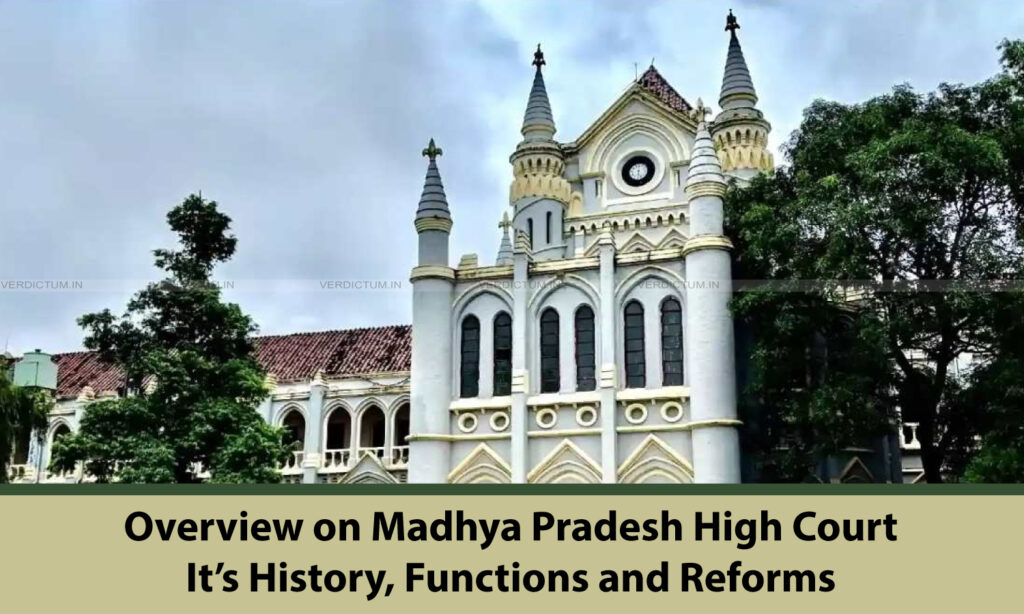1. History and Constitutional Basis
- The origins of the court go back to the Nagpur High Court, which was established by Letters Patent on 2 January 1936 under Section 108 of the Government of India Act, 1935. At that time it served the Central Provinces & Berar.
- After India adopted its Constitution (26 January 1950), the same judicial structure and powers (via the Letters Patent) continued under Articles 225 & 372.
In November 2000, when Chhattisgarh was carved out as a separate state under the Madhya Pradesh Reorganisation Act, 2000, the High Court of Chhattisgarh was established for that new state, leaving MPHC to serve the remaining Madhya Pradesh.
On 1 November 1956, with the States Reorganisation Act, Madhya Pradesh in its current form was constituted; the Nagpur High Court was deemed to become the High Court for the (new) state of Madhya Pradesh, and its seat was shifted to Jabalpur.
Also under that reorganization, temporary benches were established at Indore and Gwalior which were made permanent a bit later (28 November 1968) by Presidential Notification.
2. Structure: Seats, Benches, Judges
- Principal Seat: Jabalpur. That is where the main registry and core offices are located.
- Permanent Benches: There are two permanent benches, at Indore and Gwalior.
- Judge Strength: The sanctioned strength is 53 judges.
- These judges include the Chief Justice and puisne (ordinary) judges. The judges are appointed according to procedures under the Constitution of India (Chief Justice of India + Governor etc.). (General practice in India; though specific names/details change.)
3. Jurisdiction and Powers
- It is a High Court under the Constitution of India, so it has all the powers that high courts have: jurisdiction over civil, criminal, constitutional, administrative matters in the state of Madhya Pradesh.
- The bench at Indore, for example, has territorial jurisdiction over revenue districts in the western region of the state (Malwa & Nimar).
- It also handles writ jurisdiction (for protection of fundamental rights), appeals from district courts, revision jurisdiction, and supervisory powers over subordinate courts.
4. Case Load, Efficiency & Recent Performance
- The court has been tackling issues of pendency — large numbers of pending cases. For instance, in 2022, it disposed of 1,21,041 cases, including very old ones: one of them dating back to 1968.
- To improve efficiency, benches have extended working hours (all benches have been functioning for an additional 30 minutes), which has helped in increasing the disposal of cases.
- Under its e-Courts initiatives and digital/technological infrastructure, there has been progress toward modernization—e.g. better cause lists, digital filing and registry work.
5. Legal Aid, Access to Justice & Social Initiatives
- Through the Madhya Pradesh State Legal Services Authority (MPSLSA), many legal aid camps, awareness camps, mediation centres have been established. These help litigants who cannot afford lawyers or who need help navigating the system.
- Lok Adalat is active in the state, helping settle large numbers of cases amicably and more quickly outside traditional court hearing processes.
6. Significance
- The MP High Court plays a vital role in ensuring justice in one of the largest Indian states, both by area and population.
- Because of its benches in Indore and Gwalior, access to justice is geographically easier for people in western and northern/central parts of Madhya Pradesh rather than having everyone travel to Jabalpur.
- The court’s decisions also frequently address important constitutional issues, social justice, governance, environment, etc., impacting public policy in Madhya Pradesh.
7. Recent developments & Reforms
- Proposals to increase judge strength have been floated (to reduce delays).
- The High Court has been focusing on disposing older cases. For example, identifying cases from decades ago and giving priority to clear them. Greater use of alternative dispute resolution (ADR), mediation centres, and Lok Adalats.
8. How the Institution Works: Process & Structure
- Cases are filed in the registry, assigned to benches; hearings are done either in single judge benches or division benches depending on nature of matter (ordinary, constitutional issues, appeals).
- Lawyers practice before the High Court; there is a Bar association. Senior Advocates are designated.
- The High Court’s judgments are binding on lower courts in the state. Appeals from it go to the Supreme Court of India.
9. Tips for Litigants & Lawyers
- If you are litigating in western MP, approaching the Indore Bench may be more convenient than coming to Jabalpur.
- Keep track of cause lists online; many procedural filings can now be done electronically.
- If your matter is delayed for long, court may entertain petitions for expediting old cases, especially if fundamental rights or constitutional issues are involved.
In summary, the Madhya Pradesh High Court is an institution with a rich history and enormous responsibility. It continues to evolve—through judicial reforms, infrastructure, technology, and outreach—to meet challenges of case backlog, access to justice, and quality adjudication. If there’s a specific area you want more detail on (e.g., landmark judgments, specific procedure before MP High Court, how to approach filing a petition), I can dive into that too.
Original Post Content Sources: Madhya Pradesh High Court: History, Functions, and Key Judicial Reforms

